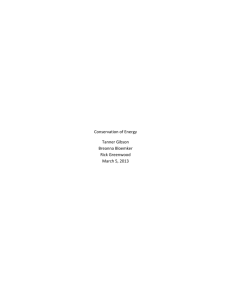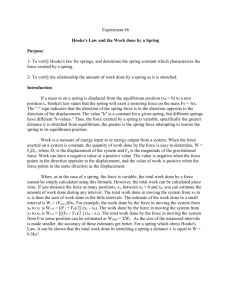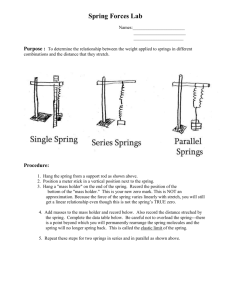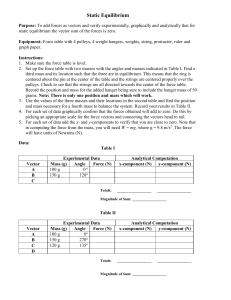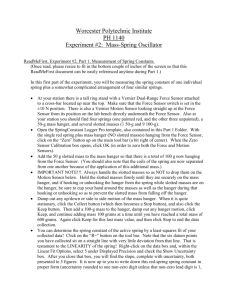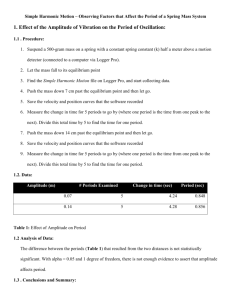Simple Harmonic Motion
advertisement
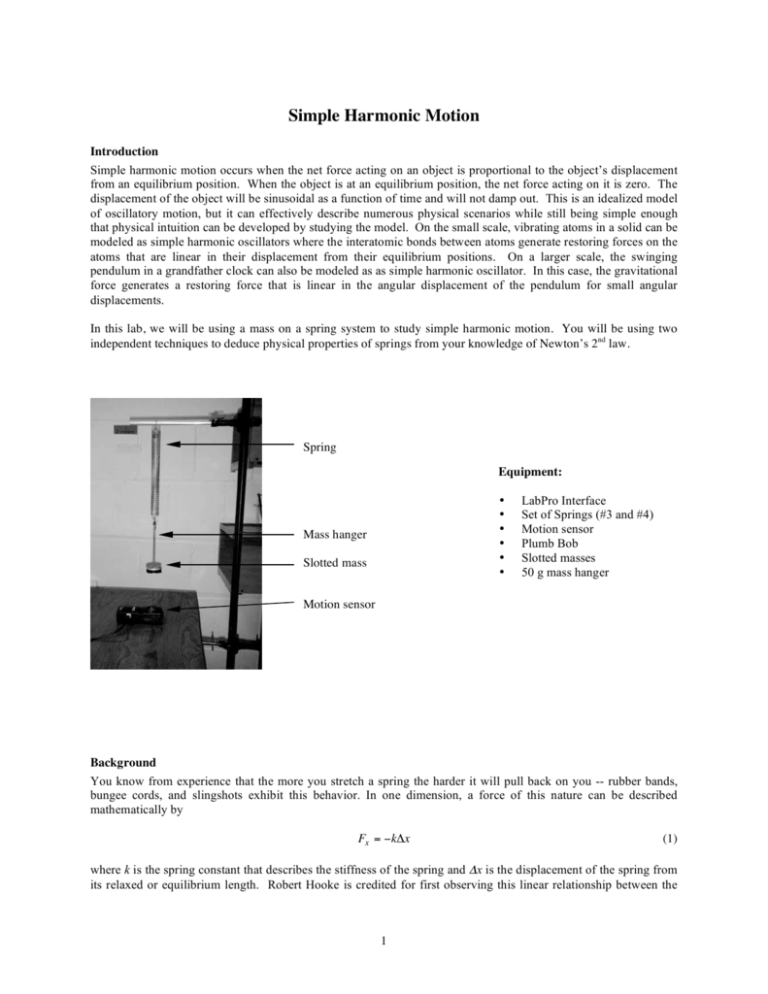
Simple Harmonic Motion
Introduction
Simple harmonic motion occurs when the net force acting on an object is proportional to the object’s displacement
from an equilibrium position. When the object is at an equilibrium position, the net force acting on it is zero. The
displacement of the object will be sinusoidal as a function of time and will not damp out. This is an idealized model
of oscillatory motion, but it can effectively describe numerous physical scenarios while still being simple enough
that physical intuition can be developed by studying the model. On the small scale, vibrating atoms in a solid can be
modeled as simple harmonic oscillators where the interatomic bonds between atoms generate restoring forces on the
atoms that are linear in their displacement from their equilibrium positions. On a larger scale, the swinging
pendulum in a grandfather clock can also be modeled as as simple harmonic oscillator. In this case, the gravitational
force generates a restoring force that is linear in the angular displacement of the pendulum for small angular
displacements.
In this lab, we will be using a mass on a spring system to study simple harmonic motion. You will be using two
independent techniques to deduce physical properties of springs from your knowledge of Newton’s 2nd law.
Spring
Equipment:
•
•
•
•
•
•
Mass hanger
Slotted mass
LabPro Interface
Set of Springs (#3 and #4)
Motion sensor
Plumb Bob
Slotted masses
50 g mass hanger
Motion sensor
Background
You know from experience that the more you stretch a spring the harder it will pull back on you -- rubber bands,
bungee cords, and slingshots exhibit this behavior. In one dimension, a force of this nature can be described
mathematically by
Fx = "k#x
(1)
where k is the spring constant that describes the stiffness of the spring and Δx is the displacement of the spring from
its relaxed or equilibrium length. Robert Hooke is credited for first observing this linear relationship between the
!
1
Simple Harmonic Motion
Physics 117/197/211
force exerted by a spring and the displacement of the spring from equilibrium. Thus, Equation (1) is sometimes
referred to as Hooke’s Law. Any force that has this general form is called a restoring force because the force that
arises due to stretching/compressing the spring seeks to restore the spring to its relaxed length. The minus sign in
the above equation ensures this behavior. If the spring is stretched in the +x direction, Δx will be positive, and the
force exerted by the spring will be in the –x direction. Stretching the spring causes the spring to generate a force
that tries to return it to its relaxed length. It is this tendency to return the spring to its equilibrium length that results
in simple harmonic motion. Hooke’s law is valid as long as the spring is not overly stretched or distorted. If the
stretch exceeds the elastic limit of the spring, it becomes permanently distorted, and it cannot return to its relaxed
length.
Consider a spring attached to a fixed post at one end and to a block that is free to slide on a low friction surface as
shown in Figure 1. Let’s look at the forces acting on the block when it is at different positions. When the spring is
relaxed (block at x = 0) as in Figure 1(b), there is no horizontal force acting on the block, so the net force on the
block in this direction is zero. This means that the velocity (speed and direction) of the block is not changing when
it is at x = 0. If the block is displaced to the right by stretching the spring [see Figure 1(c)], the spring exerts a
leftward force on the block. When the block is released, the force exerted by the spring on the block will cause the
block to move to the left. Since it is moving when it reaches x = 0, it will overshoot the equilibrium position, and
begin to compress the spring. Once the spring is compressed, it exerts a rightward force on the block [see Figure
1(a)]. This will slow down the block, bring it to rest, and then change its direction sending it back toward
equilibrium at x = 0. In the absence of friction, this oscillatory motion continues indefinitely. In real oscillators,
friction will dissipate energy from the system, and eventually bring the block to rest.
Spring exerts a
force on the
block to the right
(a)
Spring exerts no
force on the block.
(b)
Spring exerts a force on
the block to the left.
(c)
x=0
Figure 1: The force the spring exerts on a block when the spring is (a) compressed, (b) relaxed, and (c) stretched.
Note that the force the spring exerts on the block is such that it tries to return the block to the equilibrium position at
x =0.
2
Simple Harmonic Motion
Physics 117/197/211
In lab today, we will be studying a mass on a spring system, but the entire set-up will be rotated 90˚ so that the mass
hangs vertically as shown in Figure 2 below. If we apply Newton’s 2nd law to the mass attached to the spring in
Figure 2, we see that the net force acting on the mass is due to a spring restoring force and a gravitational force
r
r
r
Fnet = Fsp + Fg .
(a)
(b)
(2)
(c)
+x
x″= 0
x0
x′= 0
x1
x= 0
The mass hanger stretches
the spring by an amount xo
when the system is in
equilibrium.
The mass hanger and additional
masses stretch the spring by (x0 + x1)
when the system is in equilibrium.
Figure 2: Attaching mass to the spring causes the spring to stretch from its relaxed length. When the mass hanger is
attached to the spring, its mass causes the spring to stretch by an amount x0. When additional slotted masses are
added to the mass hanger, the spring is stretched by an additional amount x1. Once the mass comes to rest, the net
force on it is zero, and the system is in equilibrium. In this state, the upward restoring force of the spring balances
the downward gravitational force of the mass attached to the spring.
3
Simple Harmonic Motion
Physics 117/197/211
Using the coordinate systems in Figure 2, we can explicitly write out the net force on the total mass attached to the
spring in Figure 2(c):
r
Fnet = ( !kx "" ) x̂ + ( m h + m ) gx̂
= !k ( x 0 + x1 + x ) x̂ + ( m h + m ) gx̂
(3)
= #$ !kx ! k ( x 0 + x1 ) + ( m h + m ) g %& x̂
where x "" is the stretch of the spring from its relaxed state at any instant in time (not just when it is at its equilibrium
position), mh is the mass of the hanger, and m is the additional mass added to the hanger. Note that x "" is a signed
quantity that is positive when the bottom of the spring is below x "" = 0 and negative when it is above x "" = 0 .
Taking a close look at Equation (3), you may be suspicious about whether this vertical mass on a spring will exhibit
! simple harmonic motion since the net force acting on the mass has an additional constant term that is not
!
proportional to the displacement of the spring. However, orienting the mass on a spring vertically
simply sets a new
!
equilibrium position about which the mass will oscillate. We can see this most clearly by!considering the
equilibrium condition shown in Figure 2(c). When the system is in equilibrium (i.e. the net force is zero), Newton’s
2nd law tells us that
r
Fnet =
r
Fsp
{
+
! k( x0 +x1 )x̂
r
Fg
{
(4)
=0
( mh +m )gx̂
so –k(x0 + x1) = -(mh + m)g. Inserting this result into Equation (3), we see that the net force acting on the mass is
indeed proportional to the mass’s displacement from an equilibrium position,
r
Fnet = ( !kx ) x̂,
(5)
so this system, too, exhibits simple harmonic motion. However, the mass now oscillates about a new equilibrium
position ( x = 0 ) .
The displacement of this oscillating mass from its equilibrium position as a function of time can be described
mathematically by
!
x(t) = Asin[(2"t /T ) + # )]
(6)
where A is the amplitude, T is the period, and ϕ is the phase shift of the oscillation. The amplitude is a positive
constant that describes the maximum displacement from equilibrium, and the phase shift determines the
!
displacement of the mass at t=0. !The period is the length of time it takes the mass to complete one full cycle of its
motion, and it depends on the amount of oscillating mass, M, and the spring constant, k, of the spring,
M
(7)
.
k
This expression for the period is obtained by solving a differential equation that arises by applying Newton’s 2nd
law to the system of interest.
T = 2!
In the first part of this experiment, you will use a static technique where you vary the amount of mass hung from a
spring and use knowledge about the equilibrium condition for the system to determine the spring constant. In the
second part of this experiment, you will employ a dynamic technique to study the oscillatory motion of the mass on
a spring and use measurements of its period to independently infer the spring constant.
Experiment I: A Static Technique to Measure Spring Constants
When mass is attached to a spring as shown in Figure 2(c), the upward restoring force of the spring balances the
downward gravitational force acting on the mass once the system comes to rest and reaches equilibrium,
4
Simple Harmonic Motion
Physics 117/197/211
r
r
r
Fnet = Fsp + Fg = 0.
(8)
k ( x 0 + x1 ) = ( m h + m ) g.
(9)
From Figure 2, we can rewrite this expression as
For a given amount of slotted masses, m, placed on the mass hanger, we can use the Vernier motion sensor to
measure the displacement of the bottom of the mass hanger, so we will vary m and measure x1. By applying
Newton’s 2nd law to the mass hanger in Figure 2(b), we see that kx0 = mhg, so Equation (9) can be re-written as
kx1 = mg.
(10)
Your goal for this experiment is to create a plot of x1 vs. m for each of the two springs and then determine the the
spring constant of each spring from a linear fit to this data.
To prepare to make these measurements:
• Hang spring #3 from the horizontal support bar that is about 1.25 m above the table top. The spring should
be suspended from the groove in this bar to keep the spring from sliding along the bar during
measurements.
• Use the plumb line to place the motion sensor on the table directly below the spring. Then remove the
plumb line from the spring.
• Attach the mass hanger to the free end of the spring.
• Plug the motion sensor into the Lab Pro interface, and make sure that the LabPro interface has power and is
connected to a lab computer.
• Launch LoggerPro on the lab computer, and open the file “SHM_FL08_template.cmbl” from the
LoggerPro Templates folder on the desktop. Before you do anything else, perform a Save As… and save a
copy of this file to the Documents folder for your personal use. Replace “template” in the file name with
the initials of you and your lab partner to uniquely identify your version of the LoggerPro file.
• Familiarize yourself with the two pages of the LoggerPro file. Page 1 (Static Data) contains a data table, a
digital meter to measure the displacement of the mass hanger, and a graph to plot your data.
Page 2 (Dynamic Data) has a data table and two stacked graphs which will be used for the second part of
the experiment.
To acquire the data:
• Zero the motion sensor on the bottom of the mass hanger when no additional mass is added to the hanger,
and then set up the motion sensor to display a live readout (Experiment➝ Live Readout). In this state, the
motion sensor will continually measure the displacement of the mass hanger.
• Use the motion sensor to determine the displacement of the mass hanger when additional masses from 50 g
to 250 g are added to the mass hanger, taking data in 50 g increments. Enter your displacements in the data
table next to the mass data. After you have recorded displacements for all the masses, stop the live readout
for the motion sensor and save the data run (Experiment ➝ Store Latest Run). In the data table, double
click on the name of the stored data set and rename it with a name that includes the number of the spring
you are studying.
• Repeat this process for spring #4 but add 100 to 300 grams of slotted mass to the mass hanger in 50 gram
increments.
To analyze the data:
• Plot the displacement versus mass data for both springs on the same graph on Page 1 of your LoggerPro
file.
• Apply a linear fit to both data sets, and determine the spring constant of both springs from the fits to your
data.
• Be sure to include drawings of your experimental set-up, descriptions of your methods, as well as your data
tables and graphs from LoggerPro in your lab notebook.
5
Simple Harmonic Motion
Physics 117/197/211
Answer the following questions about your data:
1) Based on your observations while acquiring data, do springs with larger spring constants stretch more or less
than those with smaller spring constants when the same mass is hung from them? The spring constant is related
to the stiffness of the spring. Based on your observations and calculations, is the spring constant proportional or
inversely proportional to the stiffness? Explain your reasoning.
2) Theoretically, what should the vertical intercept be in your plots of displacement versus mass? How well do
your data agree with the theoretical value? What factors in your experimental technique could explain any
discrepancies between theory and experiment? Explain your reasoning.
Experiment II: A Dynamic Technique to Measure Spring Constants
The second technique for determining spring constants is a dynamic one. That is, one in which the motion of the
oscillating mass is observed over time, and the stiffness of the spring is determined from measurements associated
with the time-dependent motion of the mass on a spring.
Equations (6) and (7) relate the stiffness of a spring to the time-varying displacement of the oscillating mass. In this
part of the experiment, you will measure the displacement of the mass as a function of time, and use this information
to determine the period of the oscillation and ultimately the spring constant.
To prepare to make these measurements:
• Switch to Page 2 (Dynamic Data) of your LoggerPro workbook. You should see a data table and two
graphs of position versus time stacked vertically.
• Hang spring #3 vertically from the horizontal support bar. The motion sensor should again be placed on the
table directly below the spring. Use the plumb line to confirm your alignment. Attach the mass hanger to
the free end of the spring, and place 100 g of additional mass on the mass hanger.
• You will be measuring the displacement of the bottom of the mass hanger relative to this equilibrium
position, so zero the motion sensor once the system is at rest.
• In the Experiment→Data Collection menu, adjust the settings to acquire a 10 sec record digitizing 30
samples/sec.
To acquire the data:
• Pull the hanging mass down a couple centimeters (do not overstretch the spring!) and release it to set the
mass into motion.
• Click on the Collect button to acquire a 10 sec sample of the mass’s motion. You can begin acquiring data
at any point in the mass’s motion.
• Save the data run (Experiment ➝ Store Latest Run). In the data table, double click on the name of the
stored data set and rename it with a name that includes the number of the spring you are studying.
• Repeat this study using spring #4 but this time place 200 g of additional mass on the mass hanger instead of
100 g.
To analyze the data:
• On the top graph in Page 2, display the Position of spring #3 as a function of Time. Plot the same
quantities for spring #4 on the lower graph. Note: If you click on the vertical axis label of one of the
graphs and select More…, you will see all of your data sets. You will have multiple Position data runs for
the different springs you have studied. Check the Position box within the data set for the appropriate spring
to display Position on the vertical axis.
• Apply a sinusoidal custom curve fit of the form x(t) = A sin(Bt + C) to determine the period of the
oscillating mass. If this function is not listed in the General Equations list, define a new function of this
form.
• The three fit parameters (A, B, and C) have physical meanings for the motion of our oscillating mass [see
Equation (6)]. While the amplitude of the oscillation is conventionally chosen to be positive, it can also be
negative for a different choice of the phase shift. The quantity (2π/T), however, should be positive. The
curve fitting routine does not account for physical constraints, so if you get values for your coefficients that
6
Simple Harmonic Motion
•
•
•
Physics 117/197/211
do not make physical sense, try providing an initial estimate for coefficient B that has the correct sign and
order of magnitude to help the curve fitting routine converge with physically meaningful coefficients.
From the three fit parameters (A, B, and C), determine the period, and use this information to calculate the
spring constant of the spring. Think carefully about what masses are needed to calculate the spring
constant.
Calculate the percent difference between the spring constant values you obtained with the static and
dynamic measurements. Take the static value to be the “gold standard” to which you are comparing the
dynamic value.
Repeat this analysis for spring #4.
Answer the following questions about your data:
1) The dynamic method for estimating the stiffness of springs can be susceptible to errors associated with the fact
that, depending on the specific type of spring used, a significant fraction of the spring can also oscillate up and
down along with the hanging mass, effectively increasing the amount of oscillating mass. Would you expect a
spring with a small or large spring constant to be more susceptible to this sort of error (assuming the springs have
comparable masses)? Do your percent difference calculations for measuring the spring constant two different
ways support your answer? Explain.
2) For dynamic measurements of the spring constant, will you under-estimate or over-estimate the spring constant if
you assume that the spring does not contribute to your oscillating mass? Explain.
Concluding Questions
When responding to the questions/exercises below, your responses need to be complete and coherent. Full credit
will only be awarded for correct answers that are accompanied by an explanation and/or justification. Include
enough of the question/exercise in your response that it is clear to your teaching assistant to which problem you are
responding.
1.
If we have two springs suspended vertically, the first of which is four times as stiff as the second, determine
which spring will be stretched more and by how much if the same mass is hung on both springs.
2.
If the period of one oscillating spring is six times shorter than that of another when the same mass is
hanging from each spring, which spring is the least stiff and by how much compared to the other?
3.
Describe three real world examples of objects that undergo simple harmonic motion (the motion of your
examples may be damped out over time due to friction). You may not use any examples mentioned in the
lab manual or by your TA. Explain what it is about the object that leads you to believe it is a harmonic
oscillator.
7
